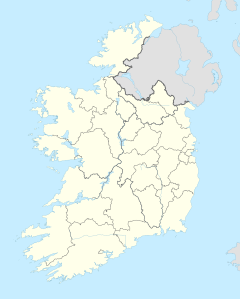Classiebawn Castle
| Classiebawn Castle | |
|---|---|
 | |
| General information | |
| Location | Mullaghmore, County Sligo |
| Country | Ireland |
| Coordinates | 54°27′18.55″N 8°28′9.59″W / 54.4551528°N 8.4693306°W |
| Completed | 1874 |
| Client | Lord Palmerston |
| Design and construction | |
| Architect(s) | J. Rawson Carroll |
Classiebawn Castle is a country house built for the 3rd Viscount Palmerston (1784–1865) on what was formerly a 4,000-hectare (10,000-acre) estate on the Mullaghmore Peninsula near the village of Cliffoney, County Sligo, Ireland.[1] The current castle was largely built in the late 19th century.
History
[edit]
The building was designed in the Baronial style by Dublin architect James Rawson Carroll, and is constructed from a yellow-brown sandstone brought by sea from County Donegal. It comprises a gabled range with a central tower topped by a conical roofed turret.
The land, which once belonged to the O'Connor Sligo family, was confiscated by the English Parliament to compensate the people who put down an Irish rebellion. Around 4,000 hectares (10,000 acres) of land on which Classiebawn now stands was granted to Sir John Temple (1600–1677), Master of the Rolls in Ireland.[2]
The property passed down to The 3rd Viscount Palmerston, a statesman who served as both British prime minister and British foreign secretary. It was this Lord Palmerston who commissioned the building of the current Classiebawn Castle and the harbour at Mullaghmore. The house was not complete upon his death in 1865 but was completed in 1874 by his stepson and successor, William Cowper-Temple (later created The 1st Baron Mount Temple). The latter died childless in 1888 and the estate passed to his nephew, the Hon. Evelyn Ashley, the second surviving son of the 7th Earl of Shaftesbury. Evelyn Ashley spent some time there each year and on his death in 1907 was succeeded by his only son, Wilfrid Ashley (later created Baron Mount Temple in a new creation). He also spent his summers at the castle with his daughters Edwina, the future Countess Mountbatten, and Mary (1906–1986), who was Baroness Delamere from 1944 until 1955 as the second wife (of three) of the 4th Baron Delamere.[2]
Mountbatten years
[edit]In 1916, the house was cleared and remained empty until 1950. It was inherited in July 1939 by Edwina Mountbatten, who, with her husband Admiral of the Fleet Louis Mountbatten, made several improvements, installing electricity and a mains water supply.[3] After his wife's death in February 1960, Mountbatten, the last Viceroy of India, spent his summers there until his death when his boat was blown up off the coast of Mullaghmore by the Provisional Irish Republican Army in August 1979.[2][4]
The castle and surrounding lands are now owned by the estate of Hugh Tunney (1928–2011), a businessman from Trillick in County Tyrone, who bought the castle and 1,200 hectares (3,000 acres) of the surrounding estate in 1991 after having leased it for many years.[2]
References
[edit]- ^ "Profile of an Irish Village-Palmerston and the Conquest, Colonisation and Evolution of Mullaghmore, Co. Sligo". Retrieved 26 September 2013.
- ^ a b c d "Classiebawn and it's [sic] owners". Retrieved 26 September 2013.
- ^ Cowell, Alan (14 June 2017). "Patricia Knatchbull, a Grande Dame of Britain's Elite, Dies at 93". The New York Times. Retrieved 12 October 2017.
- ^ Krebs, Albin (28 August 1979). "Earl Mountbatten of Burma, 79, Military Strategist and Statesman". The New York Times. Retrieved 12 October 2017.
External links
[edit]- Classiebawn castle by Lord Mountbatten
- Liam Collins: An aristocrat, a beef baron and the castle they both came to love, Independent.ie, 19 May 2016.


